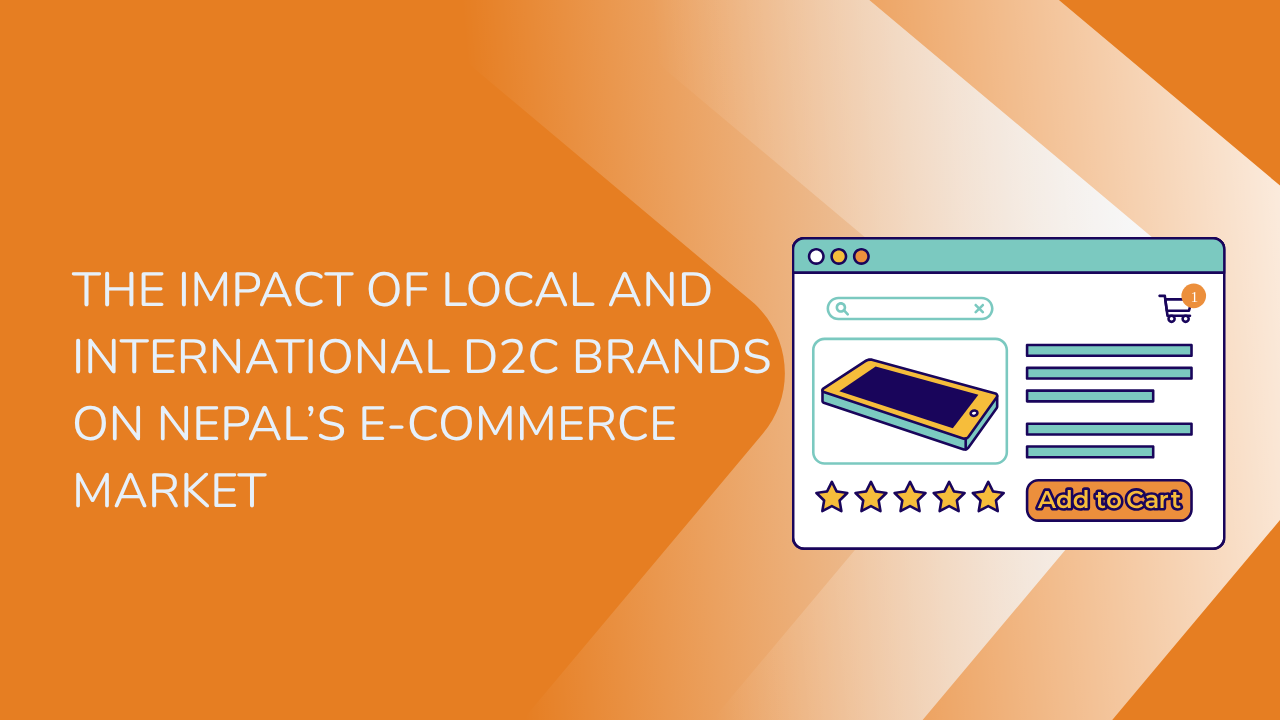Share this Article
In recent years, Direct-to-Consumer (D2C) brands have become a significant part of Nepal's evolving retail and e-commerce sector. These brands offer products directly to consumers, bypassing traditional distribution channels, which allows for a more personal and direct relationship with customers. This model has proven advantageous for many companies in Nepal as it eliminates intermediaries, lowers costs, and provides more control over branding and customer interactions. However, despite the opportunities provided by D2C business models, these companies face several unique challenges that complicate their growth and sustainability. These obstacles range from logistical problems, payment system limitations, intense competition, customer trust issues, and barriers related to purchasing power in different parts of the country.
In this article, we will explore the main challenges that D2C brands in Nepal must overcome and discuss how they are using creative and innovative strategies to address them. While D2C businesses continue to grow rapidly, the journey is far from simple, and a well-thought-out approach is necessary for sustained success in the market.
1. Logistical Challenges: Overcoming Delivery and Infrastructure Obstacles
One of the most pressing challenges for D2C brands in Nepal is the country’s logistical infrastructure. Nepal’s road network, especially in rural areas, is underdeveloped, which creates significant barriers to efficient and timely delivery. Additionally, poor transportation options, especially in hilly and remote regions, lead to delivery delays and increased costs.
Delivery Delays:
Nepal's transportation network often causes delays in delivery times, particularly in the more isolated or rural regions. These delays are further exacerbated by poor road conditions and lack of an effective transportation system. For D2C brands, ensuring timely delivery is crucial for customer satisfaction, and delays can lead to negative reviews and lost sales.
High Logistics Costs:
The cost of delivery, especially for last-mile service in remote areas, remains a challenge for D2C businesses. To deliver products efficiently, many companies must invest heavily in their logistics infrastructure, which can eat into profits. High transportation costs also make it challenging for D2C brands to offer affordable shipping options for their customers.
Solutions:
To overcome these logistical challenges, many D2C brands have adopted several strategies:
- Partnering with Local Logistics Providers: D2C brands are increasingly collaborating with local logistics companies that understand the local geography and have established networks to facilitate smoother deliveries. These logistics partners have better access to remote areas and can reduce the time and cost of deliveries.
- Creating Local Hubs: By establishing regional distribution centers or warehouses in key locations, D2C brands are able to store products closer to the final consumer. This minimizes delivery times and costs while improving overall efficiency.
- Leveraging Technology: Some D2C brands have turned to advanced tracking systems, allowing both brands and customers to monitor the status of their orders. This helps in managing expectations and building trust with customers, ensuring transparency and reducing dissatisfaction due to delays.
2. Payment System Limitations: Overcoming Digital Payment Barriers
A significant challenge for D2C brands in Nepal is the relatively low penetration of digital payment methods. While mobile wallets, bank transfers, and digital payment systems have made progress in the country, cash-on-delivery (COD) remains the dominant mode of payment. This creates difficulties for brands that want to streamline their operations and reduce the risks associated with COD.
Cash-on-Delivery Preference:
Many consumers in Nepal still prefer cash-on-delivery as it is a familiar and trusted method of payment. While this option provides comfort for the consumer, it can create several problems for D2C brands, such as increased risk of non-payment, delays in cash processing, and logistical inefficiencies.
Low Trust in Digital Payments:
Despite growing acceptance of digital transactions, many consumers, especially in rural areas, are hesitant to adopt online payment methods due to concerns about security, fraud, and unfamiliarity with online platforms. This results in slower adoption of more modern payment systems.
Solutions:
To address these payment-related challenges, D2C brands in Nepal have employed several solutions:
- Educational Campaigns for Digital Payments: Some D2C brands are actively educating their consumers on the benefits of using digital payment methods. They offer information about the security of online transactions and encourage customers to try digital payment methods through incentives like discounts or promotional offers.
- Multiple Payment Options: By integrating various payment options, such as digital wallets like eSewa, Khalti, and IME Pay, alongside traditional COD, D2C brands cater to a broad spectrum of customer preferences. This flexibility improves the chances of making sales and ensures a smoother checkout process.
- Strengthening Payment Security: As part of their efforts to build trust, many D2C brands are implementing advanced security measures, such as SSL certificates, encrypted payment gateways, and fraud detection systems. This reduces the risk of fraud and reassures customers about the safety of their transactions.
3. Competition in a Crowded Market: Standing Out from the Crowd
The rapid growth of the e-commerce sector in Nepal has led to increased competition for D2C brands. The rise of digital marketing, social media, and influencer culture has made it easier for new brands to enter the market. However, this has also led to a highly saturated market where differentiating oneself from competitors becomes challenging.
Price Wars:
In a bid to attract customers, many D2C brands engage in price wars, constantly lowering prices to stay competitive. While this strategy may help capture short-term sales, it can be unsustainable in the long run, leading to thinner profit margins and difficulties maintaining a healthy business.
Consumer Loyalty and Brand Recognition:
Building brand recognition and fostering customer loyalty can be difficult in a crowded market. With many consumers being drawn to discounts and promotions, D2C brands often struggle to create long-lasting relationships with customers, as consumer loyalty tends to fluctuate.
Solutions:
To overcome these challenges, D2C brands in Nepal focus on the following strategies:
- Differentiating Through Unique Offerings: Rather than competing solely on price, many D2C brands are focusing on offering unique products with distinctive features. These brands often incorporate a specific cultural or regional element into their product range, which appeals to local consumers.
- Enhancing Customer Experience: D2C brands are placing a heavy emphasis on customer experience, ensuring that every interaction, from browsing to post-purchase service, is seamless. Personalized services, such as product recommendations, loyalty rewards, and exceptional customer support, help brands build stronger bonds with their customers.
- Strategic Use of Influencers: Brands are increasingly partnering with influencers and social media personalities to promote their products. By leveraging the influence of these individuals, brands gain credibility and visibility among their target audience. Collaborations with local influencers are especially effective, as they resonate with the cultural values of Nepali consumers.
4. Building Customer Trust: Overcoming Skepticism in Online Shopping
In Nepal, online shopping is still a relatively new concept for many, and as a result, there is a certain level of skepticism associated with purchasing products online. Customers, particularly in rural areas, may be wary of the authenticity of products, the reliability of delivery, and the potential for fraud.
Concerns About Product Authenticity:
Many consumers are hesitant to buy products online because they are unsure about the quality of the items. There are concerns that the products received may not match the descriptions or images shown on the website.
Lack of Familiarity with Online Shopping:
In rural areas, many consumers may not be familiar with how to use e-commerce platforms, browse product listings, or make secure online payments. This lack of knowledge limits the adoption of online shopping.
Solutions:
To build customer trust, D2C brands in Nepal have implemented several strategies:
- Transparent Product Information: Brands provide clear and accurate product descriptions, high-quality images, and video demonstrations of their products to build trust with consumers. They also offer guarantees like easy returns or refunds to assure customers that they can shop with confidence.
- Customer Reviews and Testimonials: By featuring customer reviews and testimonials on their websites, D2C brands can show that their products are trusted by others. Positive feedback from existing customers helps new buyers feel more comfortable making a purchase.
- Customer Support Services: Providing dedicated customer support through chatbots, helplines, and email has become an essential part of the D2C strategy. These services help resolve any questions or issues that customers may have, enhancing their overall experience.
5. Economic Challenges: Addressing Affordability Issues
Nepal’s economy is still in the developmental stage, and there is a significant disparity in purchasing power across different regions. While urban areas such as Kathmandu enjoy higher levels of economic activity, rural areas face significant challenges related to income and purchasing power.
Low Purchasing Power in Rural Areas:
Many consumers, particularly in rural and remote areas, struggle with limited disposable income. This makes it difficult for them to afford products from D2C brands, even if these brands offer high-quality goods.
Economic Instability:
Economic fluctuations, including inflation, can affect consumers’ purchasing decisions, especially for non-essential items. This can result in lower sales for D2C brands during times of economic uncertainty.
Solutions:
To cater to a diverse consumer base, D2C brands have adopted several approaches:
- Affordable Product Lines: Some D2C brands introduce more affordable product versions, offering basic products at lower prices while maintaining quality. This enables brands to cater to a wider audience.
- Flexible Payment Options: Offering installment plans, discounts, and flexible payment terms can help make products more accessible to a broader range of customers.
- Targeted Marketing: D2C brands tailor their marketing strategies to target specific economic segments, focusing on consumers who are most likely to purchase their products. This allows brands to optimize their marketing efforts and improve conversion rates.
Conclusion
While the Direct-to-Consumer (D2C) business model is experiencing rapid growth in Nepal, it comes with several significant challenges. From logistical hurdles to payment system limitations, intense competition, and customer trust issues, D2C brands must navigate a complex landscape to achieve success. However, through innovative solutions such as local logistics partnerships, flexible payment options, customer-centric strategies, and transparent business practices, many D2C brands are overcoming these obstacles and carving out a niche in Nepal’s expanding e-commerce market.
As the market continues to evolve, D2C brands will play an increasingly critical role in shaping Nepal’s retail ecosystem, influencing how products are sold, marketed, and delivered to consumers across the country. By focusing on customer experience, building trust, and offering high-quality products at competitive prices, D2C brands can continue to thrive and contribute to Nepal’s digital economy.
Categories:
Beginner’s Guides
Tags:
Small Business







